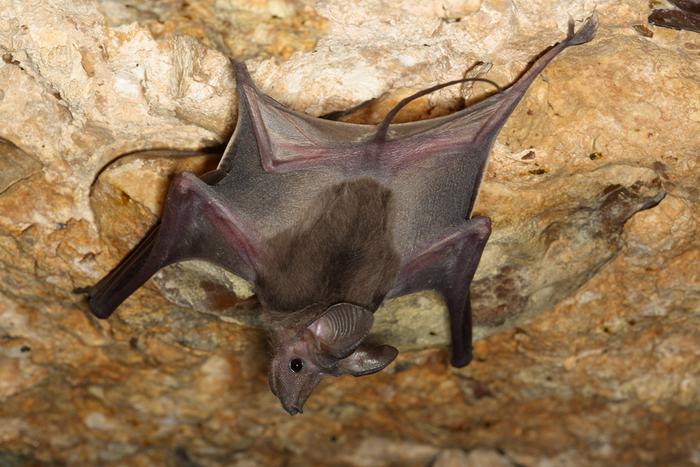
A groundbreaking study from Tel Aviv University has unlocked intriguing insights into how the Greater Mouse-Tailed Bat, scientifically known as Rhinopoma microphyllum, utilizes its elongated tail in navigation. This species, primarily found in caves, has adapted uniquely to overcome the challenges of moving backward in dark environments where vision and echolocation may be less effective. Researchers have revealed that the bat’s tail acts as a sophisticated tactile sensor, allowing it to feel its way around obstacles while maneuvering in tight spaces.
The research team, comprising students Sahar Hajyahia and Mor Taub under the guidance of Professor Yossi Yovel, employed advanced tracking technology to observe the bats as they crawled through a vertical maze, moving backward. This innovative study has demonstrated that the tail of Rhinopoma microphyllum is not just an anatomical feature, but a vital tool for navigation in challenging conditions. The findings highlight the evolutionary significance of this trait, as it enables bats to adapt to their specific ecological niches.
As the researchers focused on the bats’ movement patterns, they discovered that the Greater Mouse-Tailed Bat expertly utilized its tail similarly to a blind walker using a cane. By swinging the tail side to side, the bats could detect potential obstacles in their path, significantly improving their climbing efficiency. This is particularly crucial for survival in dark caves filled with various perils, including uneven surfaces and competing bats.
Another significant aspect of this research was the effect of local anesthetics on the bats’ tails. When the researchers numbed the tails of these creatures, there was a marked increase in climbing time by approximately 10%. Moreover, the bats exhibited a tendency to move laterally instead of upward, suggesting an increased struggle to find their way around obstacles. This pivotal observation underscores the importance of the tail in spatial awareness and navigation.
The study further delved into the bats’ ability to distinguish between various textures using their tails. For instance, they successfully differentiated between a wooden grid with 1 cm intervals versus a sparser grid of 1.5 cm. This capacity to discern subtle textural differences showcases the exceptional sensitivity of the bat’s tail, which offers a glimpse into the evolutionary adaptations within the animal kingdom.
Professor Yossi Yovel emphasized that, unlike most bats that possess short tails integrated into their wing membranes, Rhinopoma microphyllum features a long, free tail. This evolutionary divergence is particularly noteworthy, as it allows these bats to utilize their tails solely for sensory purposes. The findings from this study suggest that evolution continuously shapes animal morphology, enabling adaptations that meet specific challenges encountered in their habitats.
Moreover, the implications of this research extend beyond the natural world. Understanding how the Greater Mouse-Tailed Bat employs its tail for navigation could inspire technological advancements, particularly in robotics and artificial intelligence. The concept of reverse sensory systems in robotics could leverage insights garnered from the bat’s unique adaptations and lead to better navigation technologies designed for environments that are difficult for humans or traditional machines to navigate.
The research conducted not only sheds light on the sensory capabilities of the Greater Mouse-Tailed Bat but also contributes to our broader understanding of sensory systems across different species. It calls into question how other animals might utilize seemingly basic anatomical features in complex and innovative ways to enhance their survival and well-being in their specific environments.
Ultimately, this study highlights the intricate relationship between evolutionary biology and behavioral adaptations. By observing the subtle variations in tail function, researchers gain critical insight into how these bats have evolved to thrive in darkness. The remarkable findings advocate for continual exploration of lesser-known species, as they often hold keys to understanding the broader implications of evolutionary biology.
As we digest the revelations about Rhinopoma microphyllum, it becomes clear that seemingly innocuous adaptations can play profound roles in the survival and behavior of a species. The Greater Mouse-Tailed Bat stands as an example of nature’s ingenuity and persistence, inspiring scientists and innovators alike to harness these lessons in sensory navigation.
Through this groundbreaking research, we are reminded of the vital interconnectedness of all species and the importance of studying unique adaptations within their ecological contexts. The lessons drawn from Rhinopoma microphyllum may very well serve as a blueprint for future explorations in both biology and technology, where understanding the natural world continues to hold the potential to inform human invention.
In light of these compelling findings, we can anticipate that further studies will open new avenues for exploration regarding the sensory adaptations of various other species. As researchers continue to explore the depths of animal behavior, every new discovery brings us one step closer to comprehensively understanding the sophisticated systems of life that have evolved on our planet.
Subject of Research: Sensory Navigation in Greater Mouse-Tailed Bats
Article Title: Greater Mouse-Tailed Bat Uses Tail as Tactile Sensor for Navigation
News Publication Date: [Insert Publication Date]
Web References: [Insert Web References]
References: [Insert References]
Image Credits: Jens Rydell
Keywords: Greater Mouse-Tailed Bat, sensory navigation, tactile sensor, evolutionary biology, animal behavior, robotics, Rhinopoma microphyllum.
Tags: advanced tracking technology in wildlife studiesbats moving backward in cavesbats using tails as sensory toolsblind navigation in animalsecholocation limitations in batsecological niches of Greater Mouse-Tailed Batevolutionary significance of bat traitsGreater Mouse-Tailed Bat navigationinnovative research in animal behaviorRhinopoma microphyllum tail adaptationtactile navigation in dark environmentsTel Aviv University bat research





